
On October 25, 2021, about one month before the detection of the Omicron variant of Covid-19 in South Africa, the Biden Administration released an announcement entitled “A Proclamation on Advancing the Safe Resumption of Global Travel During the COVID-19 Pandemic.” More an adjustment of restrictions than a lifting of them, it specified that
[b]eginning in January 2022, all inbound foreign national travelers crossing into the U.S. from Canada or Mexico via land or ferry ports of entry — whether for essential or non-essential reasons — must be fully vaccinated for COVID-19 and provide proof of vaccination. This delayed implementation is intended to provide ample time for essential travelers such as truckers, students, and health care workers to get vaccinated.
And, as trade disputes tend to go, reciprocity was swift. On November 21,
Canada announced that it will require truck drivers–both Americans and Canadians–to be double vaccinated against the COVID-19 virus by Jan 15. When crossing into Canada. The announcement comes weeks after the Biden Administration proposed a mandate requiring all Canadian cross-border truck drivers to be vaccinated by January 2022 … Up to this point, truck drivers, defined as essential workers, had been permitted to cross the border for work while it has been closed to non-essential traffic.
The announcements went mostly unnoticed outside of financial and transportation news sources, but carry significant consequences for the economies of both the US and its neighbors.
Some 70 percent of the nearly $650B (2020) in trade between the US and Canada travels on trucks driven by over 150,000 truckers. Over $600B (2019) of goods are imported to and exported from Mexico on the backs of trucks. Within the United States, in fact, 68 percent of cargo is transported via trucks of various sizes, whether cross-country or locally (“last mile”).
Truck driving as an occupation, especially long-haul trucking, has been under siege for some time. Most of its problems weren’t caused by the arrival of Covid or the political response to the pandemic, but as with so many other areas of business and finance long-standing issues were both exposed and exacerbated by them.
Spending Dollars to Earn Pennies
It’s a difficult business. There’s a weighty capital expenditure component, exposure to commodity price fluctuations, a high degree of seasonality, federal and state regulations, and intense competition both within and outside the sector. Long-haul trucking, generally denoted by shipping which requires at least one night (and usually more) on the road, carries additional challenges. Among other aspects are the requirements made of drivers.
The lifestyle is rough. You barely see your family, you rarely shower, and you get little respect from car drivers, police, or major retailers. [One interviewed driver] said he has been divorced twice because of trucking. [Another] said she gained 60 pounds her first year from sitting all day and a lack of healthful food on the road.
Remuneration could compensate for those hardships to some extent, but trucking pay varies widely across corporate versus owner-operated driving, different types of freight, and various routes. While some drivers can and do earn over $100,000 per year, median annual pay has been reported as between $42,000 and $51,000. Signing and distance bonuses are called a “joke” owing to the fine print associated with them. Truckers frequently incur significant personal expenses on the road, and are subject to electronic monitoring. Perhaps most impactfully and unbeknownst to most of the public, many truckers are ineligible for overtime owing to New Deal-era regulations.
Section 213(b)(1) of the Fair Labor Standards Act states the law’s overtime requirements do not apply to those “with respect to whom the Secretary of Transportation has the power to establish qualifications and maximum hours of service.”…For someone in trucking to be exempt from overtime, three factors must be present:
1.) Their employer is a “motor carrier” according to DoT regulations
2.) Their regular job duties affect the safety of a motor vehicle used on public highways in interstate and foreign commerce
3.) Their commercial vehicle weighs at least 10,000 pounds
The regulation goes beyond truck drivers, extending to support roles (driver’s assistants, loading dock workers, and even truck mechanics). It can also be extended further, to jobs and roles which do not have an intrinsic safety component, at the direction of the Secretary of the Department of Transportation.
Wages are the price of labor, and in a truly free market would be the product of negotiation between employees and employers. Government intervention in labor markets, whether in the traditional form of minimum wages or here, in the form of a maximum wage (essentially a price ceiling), create distortions. The result of this particular intervention, though, is obvious; to no one more than truckers themselves.
According to ZipRecruiter, as of May 2021, the average annual pay for a truck driver in the United States is $50,909 a year. That works out to be approximately $24.48 an hour. But the math is just as flawed as the [overtime] exemption. That $50,909 figure assumes only 2,079 hours in the year, which is a normal 52-week year at 40 hours per week. When a driver works 70 hours in eight days (assuming two weeks off) that driver is actually working 3,071 hours, which reduces their hourly pay to $16.58 – barely above many states’ minimum wage. When measured against Walmart, McDonald’s, and Amazon, there’s little to no economic incentive for anyone to drive as a company driver, and that’s before the other externalities such as benefits, living accommodations, [and missing] friends and family are considered.
Drivers must also be 21 to drive commercially across state lines. But by 21 years of age, most young people have cast their lot in a certain trade or toward a particular degree. (Under the previous administration, the Federal Motor Carrier Safety Administration proposed a pilot program to lower the minimum age to 18.)
Neither does it help the understrength profession that on January 6, 2020–exactly two weeks before the first case of Covid was reported in the US–the Federal Drug and Alcohol Clearinghouse database went live. At a point where it is estimated that the industry is short in excess of 80,000 drivers,
Chris Pappas, CEO of Chef’s Warehouse, which provides ingredients to restaurants, told the New York Post he was short about 1,000 drivers. The number of candidates being turned away due to drug tests was “a big enough number that it hurts,” he said, without giving more detail … According to Clearinghouse’s monthly report for September 2021, 72,444 drivers had “prohibited” status. About 54,000 of these were yet to start the reassessment process required before they can return to duty. Of these people, 11,922 were eligible to be reassessed.
It would be edifying to determine how many of the 72,444 were listed within the clearinghouse (and unable to drive) owing to cannabis-related violations, even as more and more US states legalize or decriminalize its use.
Thus in trucking, employee retention is low and there are formidable barriers to entry. Artificially low pay (on the basis of hours worked) rooted in Great Depression-era policies, austere working conditions, and a variety of regulatory fetters explain why, for decades, there has been a large and growing shortage of truck drivers. In particular, a paucity of long-distance truckers.
Early Pandemic Policy Effects
Statistics reveal that pandemic policies levied in March 2020–lockdowns, stay-at-home orders, travel restrictions, and limits on occupancy–foist an extinction-level event upon owner-operators and small trucking firms. In an industry chronically understaffed,
[US] trucking company failures nearly tripled in 2020 … as fallout from the pandemic deepened pressure on smaller operators while well-capitalized bigger truck[ing firms] held on and found stronger footing[.] … Some 3,140 fleets shut down last year, a 185 percent jump from 2019, according to transportation industry data firm Broughton Capital LLC. Roughly half of the 2020 failures came in the second quarter, when freight volumes plummeted amid widespread shutdowns aimed at limiting the spread of Covid-19. “We had a record number go out of business in the second quarter and a record number in the month of May,” said Donald Broughton, Broughton Capital’s managing partner.
The Bureau of Labor Statistics estimates total long-haul trucking employment monthly.
All Employees, General Freight Trucking Long Distance (2016 – present)
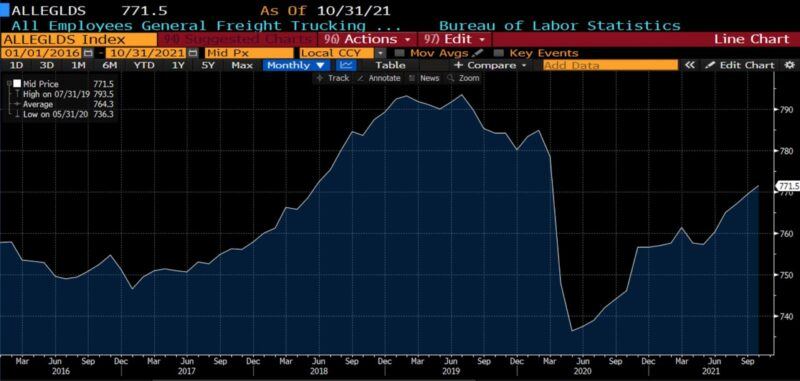
In April 2020 alone, over 88,000 truckers lost their jobs. So at the precise moment that the movement of critical goods and service inputs was of paramount importance–getting medical supplies, protective equipment, comestibles, and factor inputs where they were most needed–federal and state edicts suffocating freight transportation were imposed. (It certainly seems that if lockdowns were intended to “slow the spread” and prevent hospitals and other significant health facilities from being overwhelmed, ensuring the rapid transfer and delivery of goods would be nearly as important.)
The month that tens of thousands of truckers wound up unemployed, and over 3,000 trucking operations collapsed, Marketplace reported another government-industry divide. This one, in the pipeline for new truckers:
Dylan Francis, in Kansas City, Missouri, is ready to get out on the road. He has a job as a commercial truck driver waiting for him–once he gets his commercial driver’s license. But the DMV is closed indefinitely. “I wanna be out there doing something,” Francis said. “This was supposed to be a means of not just resources for my family, but providing resources for our country. DMVs are shut down in 27 states. And that’s not the only holdup for the trucking industry. Commercial driver training schools are shut down too … “You don’t flick a light switch and produce a driver overnight,” [one CEO] said. “We’re talking upwards of three months to get a driver trained.”
And that description is for the basic Commercial Driver’s License; more specialized types of trucking require more, and therefore longer, training periods.
Cascades
Smaller trucking interests play a critical, unheralded role in the domestic freight ecosystem. Large trucking firms tend to pursue long-term contracts with major corporations, capitalizing upon economies of scale. But smaller fleets and owner-operators tend to ply their trade in the overland spot market where odd-sized loads, freight with unique requirements, and last-minute shipping decisions take place. Rates in the spot market tend to be volatile, making the nature of that particular business one of relative feast or famine.
Lockdown and stay-at-home orders quickly sent spot market rates down 12 percent in a market where pennies per mile matter. Absent those policies, rates would likely have risen: shippers bidding per mile prices up, with small firms and independent drivers seeking the more profitable, risk-adjusted rates.
[The drop in rates] squeezed truckers like Tony Singh, owner of Richmond, VA-based Sam Trucking LLC. “April was really tough,” said Mr. Singh. At one point he feared he might have to close the business as diving shipping rates left him struggling to cover the pay for drivers, fuel, and other costs for his seven truck fleet.
Market concentration deriving from government responses to the pandemic occurred in many industries, largely owing to smaller freight operators having tighter margins and less if any cash reserves. Accordingly, smaller trucking concerns were disproportionately culled by Covid policies and their secondary effects, with “the average size of failed fleets…40 percent smaller than in 2019.”
Knock-on Costs
On top of all of this were rising insurance rates and huge fluctuations in fuel prices.
Gasoline prices (broadly) fell 25 percent between early January and late April 2020. As seen in the negative close of the May WTI contract in late April 2020, the cratering of demand coupled with a price war between Saudi Arabia and Russia led to a world awash in oil and gasoline. Unfortunately, capitalizing upon what should have been a most fortuitous development was largely prohibited in both the US and around the world; again, just when it was most needed.
Average US Gasoline & Diesel Prices (per gallon, June 2019 – present)
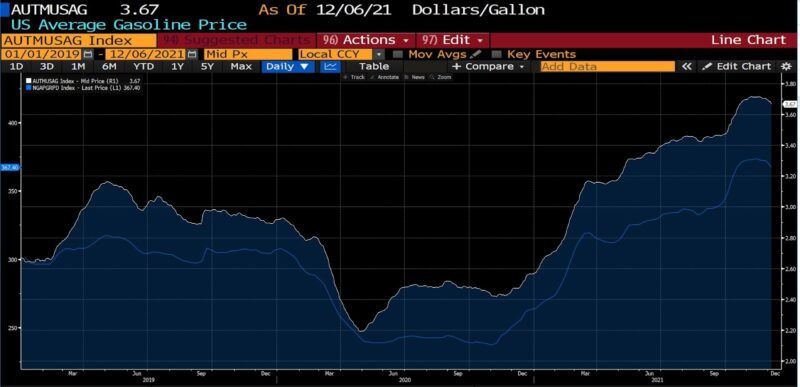
As trucks got back on the road throughout the remainder of 2020 and the first half of 2021, gasoline prices began rising sharply. From June 2020 to June 2021, per gallon prices of gasoline rose 37 percent, from $2.48 to $3.39; diesel rose in lockstep, from $2.43 to $3.30 per gallon. Diesel prices followed a similar path over the same time period. By May 2021, 14 months after the OPEC+ price war, shortages began appearing.
“I start to freak out when it hits $4 a gallon, and I’m paying almost $1,000 to fill up a 240-gallon tank,” said [one trucker] … The gasoline crunch has added a new layer of difficulty to what was already considered a difficult job … Higher prices and fuel shortages, even temporary ones, make it a lot harder for truckers to deliver goods. And as consumer spending heats up, the economy needs more truck drivers, not fewer, especially to help alleviate the current gasoline shortages.
The volatility in fuel prices, along with the precipitous drop and sudden explosion of freight volume after stimulus payments began taking effect, led to a whipsaw in the structure of overhead costs.
Freight Rates Take Off
Over the first half of 2021, freight rates continued to rise, a combination of both rising demand and limited supply; the latter where drivers, trucks, and vehicular capacity are concerned.
Cass Truckload Linehaul Index (2019 – present)
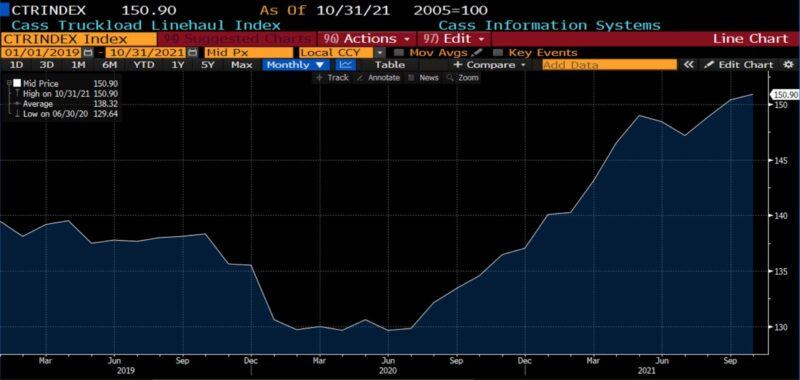
The index “isolates the linehaul component of full truckload costs from other components (e.g. fuel and accessories) providing reflection of trends in baseline truckload prices.” A look at the recent increase in light of the entire history of the index, starting in 2005, makes the size and pace of the uptick in freight shipping rates over the last fifteen months clearer:
Cass Truckload Linehaul Index (2005 – present)
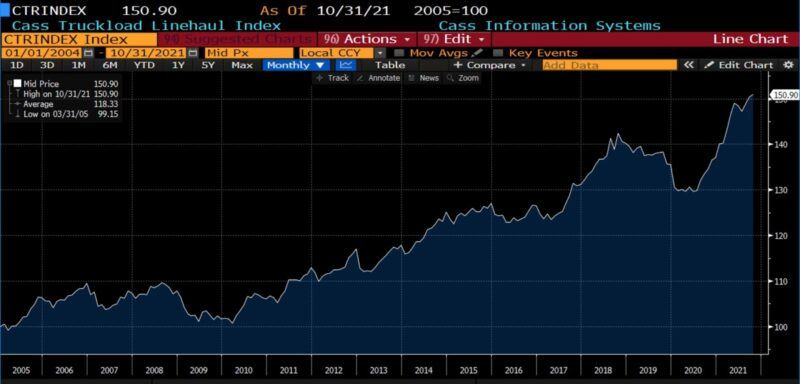
A recent report in Bloomberg, citing senior analyst Lee Klaskow, describes the impact of escalating freight rates just prior to Thanksgiving 2021:
“We expect trucking supply will be constrained beyond historical norms from restocking, economic recovery, and limited driver availability.” Increased shipping costs are adding to concerns that inflation across the US economy will be slow to dissipate. Walmart shares sagged Tuesday [November 16] by the most since May on a percentage basis after the retail giant said gross margins eased and that it’s bracing for more pressure from global transportation snarls.
In November of 2021, freight shipping data was released showing that on a year-to-year basis, rates had risen by over 36 percent.
New Armors Conspired
It is at this point that the next leg of the ongoing shipping and port crisis begins. As reported two weeks back:
Despite recent reports that congestion issues are easing on the water at California’s major ports, drayage truckers claim this isn’t the case for them – as long wait times, a flawed appointment system, and other efficiency issues continue to plague marine terminal operators in the state…An unreliable appointment system has drayage companies checking day and night to find open slots and vessel changes – which [one trucking company president] compared to playing musical chairs – have truckers concerned they won’t be able to handle a container volume increase if some of [the] issues aren’t resolved.
It’s worth noting that many of the ports are government-run. In the case of the Port of Oakland (at which on November 24th a communications director claimed “operations are normal and wait times are normal,” a view that truckers disagreed with), the facility is run as a public agency.
The City of Oakland Charter gives the Board of Port Commissioners exclusive control and management of the Port of Oakland. Our Board consists of seven members nominated by the Mayor and appointed by the City Council for four-year terms. Members must live in Oakland during their term and at least 30 days prior to their appointment. Port Commissioners donate their time to the Board as they serve without salary or compensation.
It would be presumptuous to cast aspersions blindly upon the undoubtedly hardworking and diligent political appointees at this and other ports. But if other government agencies and political boards are any guide, the incentives that appointees face are vastly different than those that confront for-profit, competitive enterprises. In the latter case, inducements are toward lowering costs and speeding up processes in order to deliver more products and services for incrementally lower prices, thereby increasing revenue and profit. In the former, actions are largely guided by the promise of future, higher political offices and accumulating coercive power over private individuals and firms.
Are Trucking Problems Frictional or Structural?
Trucking at ports is the newest chokepoint, and a number of solutions have been proposed to arrest the incremental growth of container stacks on and around ports. In October 2021, President Biden vaguely suggested deploying the National Guard, a questionable proposition at best: what, in light of the nature of current setbacks, would citizen-soldiers do behind the wheel that private citizens can’t or couldn’t?
In California, where the aforementioned Port of Oakland, the Port of Los Angeles, and other congested sites are located, state transportation officials have proposed increasing vehicular weight restrictions. But the plan, which would involve issuing permits raising the permissible gross vehicle weight from 80,000 to 88,000 pounds, has notable flaws.
Since there’s no way to add cargo to shipping containers that were weighed and sealed overseas to comply with US highway weight limits…[the] effectiveness [upon containers which left foreign ports months ago is questionable] … The California Department of Transportation order would [also] require truckers to ensure the gross weight of 88,000 pounds is distributed properly across the axles, which would mean adding additional axles to the truck and trailer in order to remain legal … “This would require specialty equipment – and adding an axle on 40-foot chassis that are already in high demand to handle these overweight containers would be a challenge,” [a trucking executive said]. “Chassis makers can’t build them fast enough and now you’re asking for specialty equipment.”
Yes, it would help to encourage adventurous, fit senior citizens to consider trucking as a second or late-in-life career. And yes, self-driving vehicles may alleviate some of the hindrances – eventually. And further back in the chain of causality: better ports, more competition along coasts, and dealing with other problems would in time bring greater efficiency and reduce single points of failure at each individual link in the supply chain.
Merchant Wholesalers Inventories, Percentage Monthly Change (2016 – present)
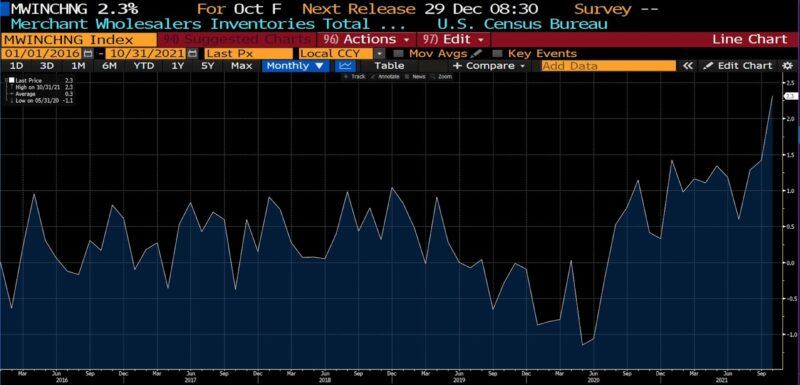
But the trucking muddle is fundamentally structural in nature. Until or unless federal exemptions on overtime, age limitations, and unwarranted puritanical restrictions on entering the profession are addressed, it is likely immedicable.
Commercial viability and public health in market economies depend upon functional, integrated means of production and consumption. Transportation systems–trucking, foremost of all–comprise the circulatory system of a market economy, tying together production and consumption by facilitating distribution and exchange. Free market economies provide for higher standards of living and longer lives than more centralized, controlled ones. Barriers to trade, such as the Biden Administration’s vaccine mandate for foreign truckers, endanger the lifeline of goods and services brought by comparative advantage.
All of this began with disease mitigation policies which on the eve of initiation were doomed to fail. Twenty months after the arrival of Covid, the domino effect of the political choice to occlude economic activity continues to permeate and negatively impact significant aspects of lives, domestic and beyond. Omicron is upon us and a Pi variant is coming, heedless of science or superstition. It would be best for the US, Canada, and the rest of the world to face the coming waves with robust, unfettered trade in operation.
* This article was originally published here
HELP STOP THE SPREAD OF FAKE NEWS!
SHARE our articles and like our Facebook page and follow us on Twitter!




0 Comments